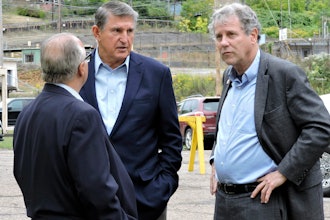Troy, Ohio — Beep, beep. A single scan in 1974 at the Marsh Supermarket in Troy, Ohio. In 2014, five billions scans each day around the world.
Today Marsh Supermarkets celebrates the 40th anniversary of the first item (a package of gum) ever scanned for a purchase in a retail location at the store in Troy which was the beta center for the technology that revolutionized retailing forever.
“Since its beginnings in the 1930s, Marsh has been on the forefront of change and growth in the supermarket industry,” said Tom O’Boyle, CEO and President of Marsh Supermarkets. “Our store in Ohio was near the NCR scan study and development facility and we worked closely together with them, Hobart Corporation and Spectra Physics to bring the idea to fruition. It seems quite unbelievable that a single event in Troy, Ohio, could launch a technological revolution that touches businesses of all kinds around the world.”
Although barcodes were invented in the late 1940s, the technology to read them didn’t exist. It was the supermarket industry that moved the idea forward. “We knew that technology like this would significantly improve the customer experience speeding up check-out time, keeping the shelves properly stocked and keep prices competitive because of the efficiencies gained everywhere from the warehouse to the store shelf,” O’Boyle said.
It wasn’t always easy in the first weeks and days at the Troy Marsh. “We had visitors from everywhere around who came to see the technology and learn about the steps we took to get the project finished,” said Claude Fenstermaker, store manager who was a co-manager there in 1974. “We also had to deal with customers’ concern that the prices were not visible on the products. Remember, this was before shelf tags. We ended up printing labels and adding them to the products to ease their minds,” he added.
Today the Universal Product Code (UPC) is part of our everyday life. Barcodes are used by millions of businesses and organizations around the world to track and identify retail products, manufacturing materials, marathon runners, event tickets, chemicals, hospital patient information and more.
“What started as a way to speed grocery store checkout has become a common standard for industries around the world to identify, capture, and share information about products and locations in real-time, said Bob Carpenter, president and CEO, GS1 US, an information standards organization and administrator of the UPC barcode. The UPC is fundamental to commerce and the most recognized standard for use at point of sale. It has also set the foundation for newer barcode standards that have evolved with the changing pace of business to offer more information about items and locations in an effort to improve the efficiency and visibility of supply and demand chains globally.”
A good idea, a progressive industry and collaboration between manufacturers and retailer created the novel technology that is one of the most recognizable sounds (beep beep) around the world.
About Marsh Supermarkets
Headquartered in Indianapolis, Marsh operates 61 Marsh Supermarkets, 15 MainStreet Markets and 3 O’Malia’s Food Markets in Indiana and Ohio, with 40 Indiana pharmacy locations. Marsh has the distinction of being the first grocery store in the world to use electronic scanners to ring up purchases.






















